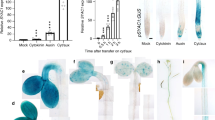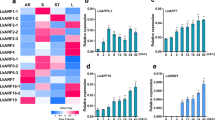Abstract
The plant hormone auxin activates many early response genes that are thought to be responsible for diverse aspects of plant growth and development1. It has been proposed that auxin signal transduction is mediated by a conserved signalling cascade consisting of three protein kinases: the mitogen-activated protein kinase (MAPK), MAPK kinase (MAPKK) and MAPKK kinase (MAPKKK)2. Here we show that a specific plant MAPKKK, NPK1 (ref. 3), activates a MAPK cascade that leads to the suppression of early auxin response gene transcription. A mutation in the kinase domain abolishes NPK1 activity, and the presence of the carboxy-terminal domain diminishes the kinase activity. Moreover, the effects of NPK1 on the activation of a MAPK and the repression of early auxin response gene transcription are specifically eliminated by a MAPK phosphatase4. Transgenic tobacco plants overexpressing the NPK1 kinase domain produced seeds defective in embryo and endosperm development. These results suggest that auxin sensitivity may be balanced by antagonistic signalling pathways that use a distinct MAPK cascade in higher plants.
This is a preview of subscription content, access via your institution
Access options
Subscribe to this journal
Receive 51 print issues and online access
$199.00 per year
only $3.90 per issue
Buy this article
- Purchase on Springer Link
- Instant access to full article PDF
Prices may be subject to local taxes which are calculated during checkout




Similar content being viewed by others
References
Abel, S. & Theologis, A. Early genes and auxin action Plant Physiol. 111, 9–17 (1996).
Mizoguchi, T. et al . Characterization of two cDNAs that encode MAP kinase homologues in Arabidopsis thaliana and analysis of the possible role of auxin in activating such kinase activities in cultured cells Plant J. 5, 111–122 (1994).
Banno, H. et al . NPK1, a tobacco gene that encoded a protein with a domain homologous to yeast BCK1, STE11, and Byr2 protein kinases Mol. Cell. Biol. 13, 4745–4752 (1993).
Sun, H. et al . MKP-1 (3CH134), an immediate early gene product, is a dual specificity phosphatase that dephosphorylates MAP kinase in vivo Cell 75, 487–493 (1993).
Sheen, J. Metabolic repression of transcription in higher plants Plant Cell 2, 1027–1038 (1990).
Sheen, J. Protein phosphatase activity is required for light-inducible gene expression in maize EMBO J. 12, 3497–3505 (1993).
Jang, J.-C. & Sheen, J. Sugar sensing in higher plants Plant Cell 6, 1665–1679 (1994).
Sheen, J. Ca2+-dependent protein kinases and stress signal transduction in plants Science 274, 1900–1902 (1996).
Sheen, J. Mutational analysis of protein phosphatase 2C involved in abcisic acid signal transduction in higher plants Proc. Natl Acad. Sci. USA 95, 975–980 (1998).
Hagen, G. et al . Auxin-induced expression of the soybean GH3 promoter in transgenic tobacco plants Plant Mol. Biol. 17, 567–579 (1991).
Chiu, W. et al . Engineered GFP as a vital reporter in plants Curr. Biol 6, 325–330 (1996).
Ulmasov, T. et al . ARF1, a transcription factor that binds to auxin response elements. Science 276, 1865–1868 (1997).
Kieber, J. J. et al . CTR1, a negative regulator of the ethylene response pathway in arabidopsis, encoded a member of the RAF family of protein kinases. Cell 72, 427–441 (1993).
Sheen, J. et al . Green-fluorescent protein as a new vital marker in plant cells. Plant J. 8, 777–784 (1995).
John, M. et al . Cell signalling by oligosaccharides. Trends Plant Sci. 2, 111–115 (1997).
Hirt, M. Multiple roles of MAP kinases in plant signal transduction. Trends Biol. Sci. 2, 11–15 (1997).
Zhang, S. & Klessig, D. Salicylic acid activates a 48-kD MAP kinase in tobacco. Plant Cell 9, 809–824 (1997).
Takenaka, K. et al . Activation of the protein kinase p38 in the spindle assembly checkpoint and mitotic arrest. Science 280, 599–602 (1998).
Widmann, C. et al . MEK kinase 1, a substrate for DEVD-directed caspases, is involved in genotoxin-induced apoptosis. Mol. Cell. Biol. 18, 2416–2429 (1998).
Machida, Y. et al . Plant MAP kinase cascade that is mediated by MAPKKK-related kinase NPK1: Possible involvement in the regulation of the M phase (40th NIBB Conf. Stress response, (1998)).
Nakashima, M. et al . The expression pattern of the gene for NPK1 protein kinase related to mitogen-activated protein kinase kinase kinase (MAPKKK) in tobacco plant: correlation with cell proliferation. Plant Cell Physiol. 39, 690–700 (1998).
Leyser, O. Auxin signalling: Protein stability as a versatile control target. Curr. Biol. 8, R305–R307 (1998).
del Pozo, J. C. et al . The ubiquitin-related protein RUB1 and auxin response in arabidopsis. Science 280, 1760–1763 (1998).
Guilfoyle, T. J. Aux/IAA proteins and auxin signal transduction. Trends Plant Sci. 3, 205–207 (1998).
Ulmasov, T. et al . Aux/IAA proteins repress expression of reporter genes containing natural and highly active synthetic auxin response elements. Plant Cell 9, 1963–1971 (1997).
Kyriakis, J. M. & Avruch, J. Sounding the alarm: protein kinase cascades activated by stress and inflammation. J. Biol. Chem. 271, 24313–24316 (1996).
Nishihama, R. et al . Possible involvement of different splicing in regulation of the activity of Arabidopsis ANP1 that is related to mitogen-activated protein kinase kinase kinases. Plant J. 12, 39–48 (1997).
Klimczal, L. J. et al . Multiple isoforms of arabidopsis casein kinase I combine conserved catalytic domains with variable carboxyl-terminal extensions. Plant Physiol. 109, 687–696 (1995).
Gleave, A. P. Aversatile binary vector system with a T-DNA organizational structure conducive to efficient integration of cloned DNA into the plant genome. Plant Mol. Biol. 20, 1203–1207 (1992).
Jang, J.-C. et al . Hexokinase as a sugar sensor in higher plants. Plant Cell 9, 5–19 (1997).
Acknowledgements
We thank T. Ulmasov and T. J. Guilfoyle for the GH3–GUS construct; J.-C. Jang for the tobacco cDNA; M. Minet for the Arabidopsis cDNA library; H. Sun and N. K. Tonks for the MKP1 cDNA; and T. Jones, A. Khokhlatchev, G. Lazar, J. Nardone and J. Nishio for comments on the manuscript. J.S. is supported by Hoecht A.G., USDA and NSF.
Author information
Authors and Affiliations
Corresponding author
Rights and permissions
About this article
Cite this article
Kovtun, Y., Chiu, WL., Zeng, W. et al. Suppression of auxin signal transduction by a MAPK cascade in higher plants. Nature 395, 716–720 (1998). https://doi.org/10.1038/27240
Received:
Accepted:
Issue Date:
DOI: https://doi.org/10.1038/27240
This article is cited by
-
An effector–reporter system to study cellular signal transduction in strawberry fruit (Fragaria ananassa)
Horticulture Research (2021)
-
The TOR–EIN2 axis mediates nuclear signalling to modulate plant growth
Nature (2021)
-
Prediction of auxin response elements based on data fusion in Arabidopsis thaliana
Molecular Biology Reports (2018)
-
Global Identification, Classification, and Expression Analysis of MAPKKK genes: Functional Characterization of MdRaf5 Reveals Evolution and Drought-Responsive Profile in Apple
Scientific Reports (2017)
-
A highly efficient grapevine mesophyll protoplast system for transient gene expression and the study of disease resistance proteins
Plant Cell, Tissue and Organ Culture (PCTOC) (2016)
Comments
By submitting a comment you agree to abide by our Terms and Community Guidelines. If you find something abusive or that does not comply with our terms or guidelines please flag it as inappropriate.



